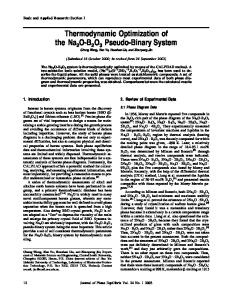Critical evaluation and optimization of the thermodynamic properties and phase diagrams of the CaO-Al 2 O 3 , Al 2 O 3 -
- PDF / 881,995 Bytes
- 10 Pages / 603.28 x 783.28 pts Page_size
- 53 Downloads / 387 Views
I.
INTRODUCTION
IN a thermodynamic "optimization," all available thermodynamic and phase equilibrium data for a system are evaluated simultaneously in order to obtain one set of model equations for the Gibbs energies of all phases as functions of temperature and composition. From these equations, all of the thermodynamic properties and the phase diagram can be back-calculated. In this way, all the data are rendered self-consistent and consistent with thermodynamic principles. Thermodynamic property data, such as activity data, can aid in the evaluation of the phase diagram, and phase diagram measurements can be used to deduce thermodynamic properties. Discrepancies in the available data can often be resolved, and interpolations and extrapolations can be made in a thermodynamically correct manner. A small set of model parameters is obtained. This is ideal for computer storage and calculation of properties and phase diagrams. We are currently engaged in a systematic analysis of oxide systems with a view to developing a comprehensive database for molten and solid oxide phases for the system SiOz-A1203-CaO-MgO-MnO-FeO-Na20-K20TiO2-Ti203-ZrO2-S. The first stage has been the optimization of all binary subsystems and is now completed. In a second stage, models are used to predict the thermodynamic properties of ternary solutions from the optimized model parameters of the constituent binaries. Ternary phase diagrams can be calculated from these estimated properties. The predictions are compared with measured ternary properties and phase diagrams, when these are available, and when necessary, small optimized ternary parameters are added. Finally, from the optimized binary and temary parameters, thermodynamic properties and phase diagrams of multicomponent systems can be predicted. The present article GUNNAR ERIKSSON, Associate Researcher, and ARTHUR D. PELTON, Co-Director, are with the Centre for Research in Computational Thermochemistry, Ecole Polytechnique, Montreal, PQ, Canada H3C 3A7. Manuscript submitted October 5, 1992. METALLURGICAL TRANSACTIONS B
reports on the evaluation of the CaO-A1203 and A1203SiO2 binary systems and the CaO-A1/O3-SiO2 ternary system. The optimization of the CaO-SiO2 system was reported previously, m For the molten slag phase, we have used our modified quasichemical model, f2-131Details of the model have been given previously, t2'41 and the equations for binary systems have been summarized in a recent submission to this journal, tl3] A brief outline of the model for a ternary system is given below. This includes, for the first time, a description of the inclusion of ternary terms. All temperatures in this article have been corrected to the International Temperature Scale of 1990.
II. T H E M O D I F I E D QUASICHEMICAL MODEL In a molten slag AO~-BO,-CO~, we consider the formation of second nearest-neighbor (i-j) bonds from (i-i) and (j-j) bonds: (A-
A)+ (B- B)=2(A-B)
(B-B)
+ (C-C)=2(B-C)
(C-C)+(A-A)=
2(C-A)
[11 [21 [3]
The Gibbs energy changes for these reactions are represented by (W
Data Loading...











